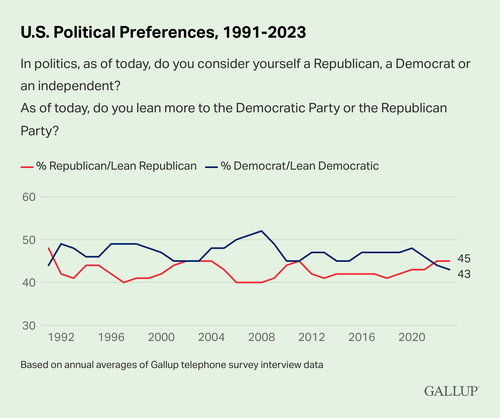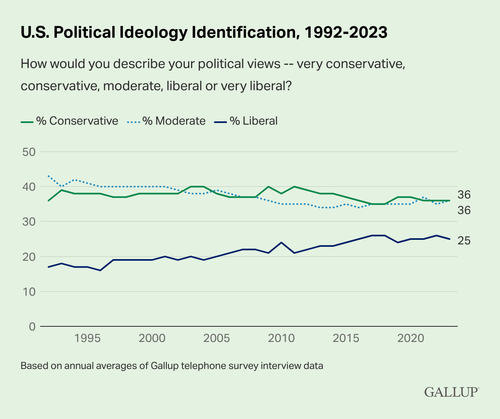A Gallup poll released on Friday reveals that a record low percentage of Americans who identify as Democrats in 2023 hit a record low, when independent ‘leaners’ are excluded.
Just 27% of Americans self-identify as Democrats, the smallest figure in the party’s history according to the survey. That said,self-identifying Republicans also hit 27%, though it did not mark the lowest figure in the party’s history – which was in 2013 when just 25% of Americans identified as such. The previous low for Democrats was in 2017 and 2015 at 29%.
Independents, meanwhile, take the cake – with 43% of Americans identifying as such.
Gallup 2023 average: Do you consider yourself a Republican or a Democrat? (with Indie leaners)
Republican: 45%
Democrat: 43%Best numbers for GOP since 1991
—
Without leaners:43% identified as independents, tying 2014 record
27% identify as Democrats (record low)… pic.twitter.com/60SsG3mVyC
— InteractivePolls (@IAPolls2022) January 12, 2024
More via Gallup:
Independent Leanings Give Republicans a Slight Edge in Party Preferences
All Gallup survey respondents who identify as independents are then asked whether they lean more toward the Republican Party or the Democratic Party. Last year, slightly more independents leaned Republican than leaned Democratic. As a result, a combined 45% of U.S. adults identify as Republicans or lean toward the GOP, while 43% are Democrats or Democratic leaners.
The 2023 figures are similar to those from 2022, when Republicans had a one-point advantage (45% to 44%). Republican advantages have been rare since Gallup first began measuring independent political leanings on a regular basis in 1991. In fact, 2023 is just the third time Republicans have had even a slight edge, along with 1991 and 2022.
In most years, there have been more Democrats and Democratic leaners than Republicans and Republican leaners, though the two partisan groups were tied in 2002, 2003 and 2011.

Conservatives, Moderates Tie for Top Ideological Identification
In addition to measuring their affiliation with either of the major political parties, Gallup asks Americans in each survey to describe their political views on a liberal to conservative spectrum. In 2023, on average, 36% of U.S. adults described their political views as conservative, 36% as moderate and 25% as liberal. Ideological identification has changed little in recent years; the latest figures essentially match the averages over the past 10 years.
From a longer-term perspective, the notable change has been the increase in liberal identification, which was under 20% from 1992 to 2000 and in 2002 and 2004. Both conservative and moderate identification have dipped slightly over the past two decades, but there has been a larger drop for moderates than conservatives since the trend began — moderates were the biggest group from 1992 to 2002.

As Gallup has previously documented, the increase in liberal identification reflects big shifts in how Democrats describe their political views. Last year, 53% of Democrats identified as liberal, 35% as moderate and 11% as conservative. While similar to the level in 2022, the 53% liberal figure is up from 43% in 2013, 32% in 2003 and 25% in 1994 (the first year Gallup analyzed ideology by party identification).
Nearly three-quarters of Republicans, 73% (essentially unchanged from 2022, but also up long term), describe themselves as conservative, with most of the rest, 22%, saying they are moderate.
Following the normal pattern for independents, the plurality of this group, 48%, identify as political moderates, while 30% are conservatives and 20% liberals.
Implications
As 2024 begins, the parties are closely matched based on political party identification and leanings. However, Democrats are clearly in a weaker position than they have been in any recent election year. This is based on the new low percentage of U.S. adults identifying as Democrats, as well as the Republican advantage in leaned party identification. In the past four presidential election years, Democrats had at least a five-point advantage in leaned party identification. They won the popular vote each of those years, though Republican Donald Trump won the 2016 election based on the Electoral College vote.
This presidential election year is likely to see a drop in the percentage of political independents, as has occurred in six of the past seven presidential election years (all but 2012), amid intense focus on national politics and the two major parties. Still, even with a slight election-year drop — which has ranged from two to five points — independents will remain the largest, and arguably most persuadable, group of voters. In what is expected to be a close election contest, it is critical for each party, but especially Democrats, to nominate a candidate who can appeal to independent voters.



